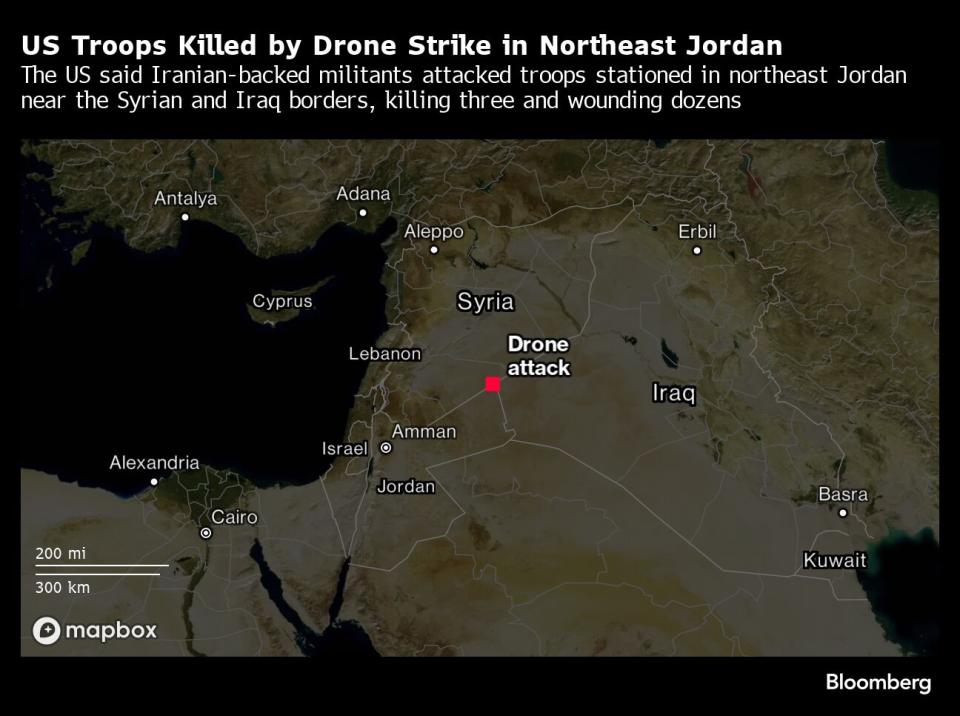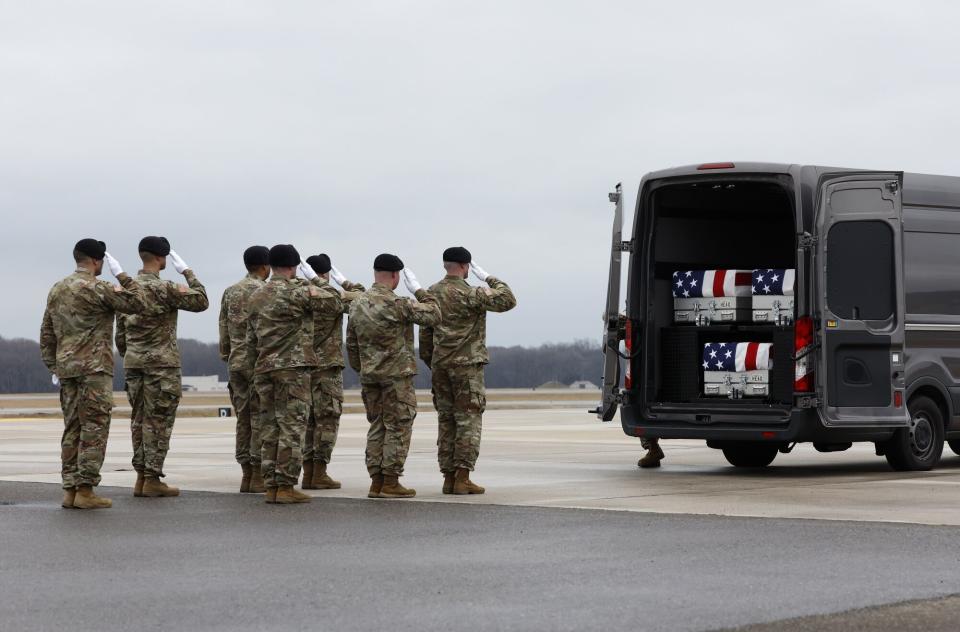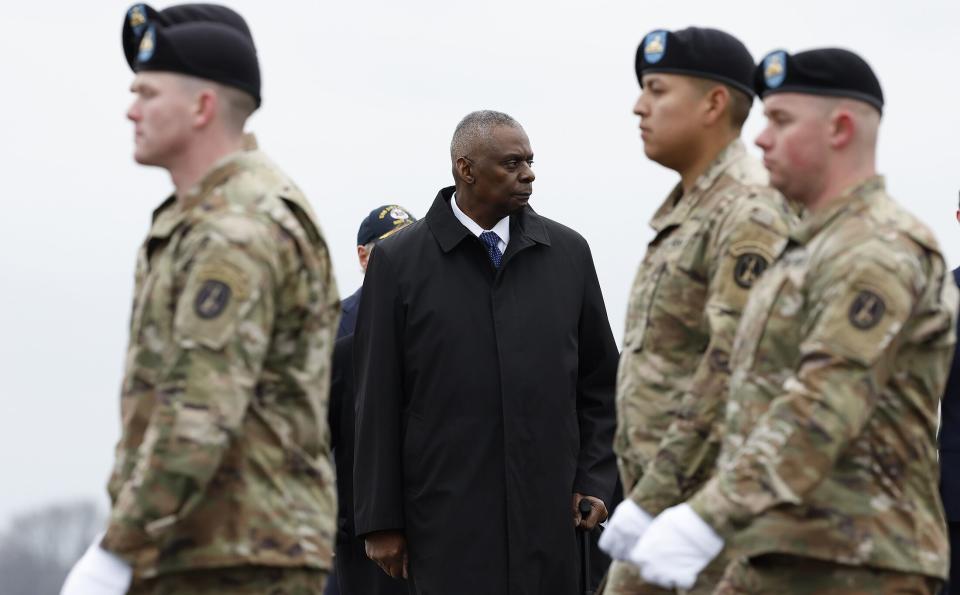US Hits Iran’s Militias in Syria, Iraq, Raising Escalation Fears
- Oops!Something went wrong.Please try again later.
- Oops!Something went wrong.Please try again later.
(Bloomberg) -- The US launched airstrikes against Iranian forces and militias in Syria and Iraq in retaliation for a drone attack that killed three American soldiers, pulling the Biden administration deeper into the conflict that erupted when Hamas militants struck Israel in October.
Most Read from Bloomberg
Iraq warned of potential “disastrous” consequences for national and regional security and stability from the strikes, and European foreign ministers meeting in Brussels urged all parties to avoid further escalation.
The US military action was a “violation of Iraq’s sovereignty,” General Yehia Rasool, a spokesperson for Iraq’s prime minister, said in a statement reported by Agence France Presse. The Syrian military said “a number of civilians and soldiers” had been killed or wounded in the strikes,” with “significant” damage incurred to property.
Aircraft including long-range B-1 bombers flown from the US struck 85 targets at seven locations linked to Iran’s Islamic Revolutionary Guards Corps’ Quds Force and to militant groups that Iran funds, according to US officials. Targets included command-and-control facilities and supply depots for rockets, missiles and drones, US Central Command said.
The airstrikes had been seen as all but inevitable after the Jan. 28 attack on a US base in Jordan, in which three soldiers were killed and many more were wounded. President Joe Biden had sought to calibrate the US response to send a message to Iran and degrade the militant groups’ ability to attack American forces while avoiding a bigger conflict.
“Our response began today,” Biden said in a statement. “It will continue at times and places of our choosing.”
More strikes will take place “in the coming days,” National Security Council spokesman John Kirby told reporters. Biden has so far elected not to target Iranian territory, a move that would have almost certainly provoked a counterattack and risked war with a key regional adversary.
Even so, targeting the Quds force — which is responsible for the IRGC’s foreign operations — marks a significant escalation in the conflict that began with the Hamas attack on Israel and Israeli forces’ subsequent military campaign in the Gaza Strip. The US has become increasingly embroiled in the conflict, launching repeated strikes to defend US troops in Syria and Iraq, and targeting Iran-backed Houthi militants in Yemen that have hit commercial shipping in the Red Sea, a vital trade waterway.
How Iran-Backed Groups Provoke Wider Mideast Conflict: QuickTake
Josep Borrell, the EU’s top foreign affairs official, told reporters on Saturday that the Middle East is like “a boiler that can explode.”
“We call on everybody to try to avoid an escalation,” Borrell said before the start of the Brussels meeting. His comments were echoed by other officials. “Our common goal has to be to prevent a spillover,” said Austrian Foreign Minister Alexander Schallenberg. “This is a powder keg.”
The US attacks came days before Secretary of State Antony Blinken is set to return to the region in a bid to help secure a cease-fire and hostage deal in Gaza that officials believe could serve as a tentative step toward ending the conflict between Israel and Hamas.
While backing Israel’s right to defend itself after the Oct. 7 attack, US officials believe a cease-fire could help ease tensions and deny Iranian proxies a reason to keep attacking American forces.
Defense Secretary Lloyd Austin said in a statement that Biden has directed more action against the IRGC and militias backed by the group, though he didn’t say when that would happen. US bases scattered across Iraq and Syria had come under attack more than 160 times in the weeks since Hamas’s Oct. 7 attack on Israel, though no US soldiers had been killed until last week.
The US strikes targeted “logistics and munition supply chain facilities of militia groups and their IRGC sponsors who facilitated attacks against US and Coalition forces,” Central Command said. Briefing reporters afterward, US officials said the airstrikes had lasted about 30 minutes and that Iraqi government was informed beforehand. They said three of the sites were in Iraq and four were in Syria and that good weather in the targeted locations contributed to the timing of the strikes.
Earlier Friday Biden was joined by family members of the three slain Americans for the return of their remains to US soil. Biden, first lady Jill Biden and Austin witnessed the unloading of three flag-draped coffins at Dover Air Force Base in Delaware.
The US blamed last week’s deadly attack on an Iranian-backed umbrella group known as the Islamic Resistance in Iraq. That group is part of what’s known as the Axis of Resistance, a web of anti-Israel and anti-US militants in the region that encompasses groups in Syria, Lebanon and Yemen, as well as Hamas in the Gaza Strip. It also includes the Kata’ib Hezbollah militant group, which said earlier in the week that it was halting military operations in Iraq after pressure from the Iraqi government.
Earlier: Binance Sued by Hamas Hostage, Families of Victims in Attack
Like the US, Iranian officials have sought to balance promises of retaliation against assurances that they don’t seek a wider conflict. Earlier in the week, an IRGC commander said the country wasn’t seeking a confrontation with the US but has “no fear of war.”
And Iran’s ambassador to the United Nations, Amir Saeid Iravani, said “If any party attacks Iran’s territory, or its interests or citizens abroad, it will be met with a decisive response,” according to state-run media.
--With assistance from Daniel Flatley, Courtney McBride, Jordan Fabian, Josh Wingrove, Natalia Drozdiak and Katharina Rosskopf.
(Updates with comments from Iraqi, European officials from third paragraph.)
Most Read from Bloomberg Businessweek
A Brutal Crime Crackdown Is Emboldening Leaders Across Latin America
Mano dura de El Salvador contra el crimen seduce a América Latina
Chinese Students Abroad Struggle With Tuition as Economy Falters
©2024 Bloomberg L.P.




